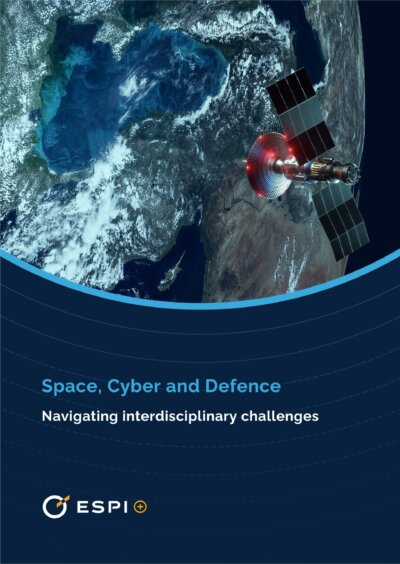1. The rise of commercial space for defence applications
From its start, the war in Ukraine has triggered the extensive use of commercial space solutions (e.g. in Earth observation with Iceye or connectivity with Starlink) and showcased the added value of commercial space actors for security and defence missions. However, the increased use of commercial solutions has also led to practical questions on the ways to streamline their use in military operations and change their status from complementary to integrated capabilities. Over the past months, reflection on this topic, as well as on the relations between private companies and military structures, has accelerated, especially in the United States. The latter published two complementary strategies targeting the commercial-military nexus in April 2024: the Department of Defense’s Commercial Space Integration Strategy (CSIS) and the U.S. Space Force’s Commercial Space Strategy (CSS).
As the increase in the number and diversity of commercial space actors is also unfolding in Europe, the extent to which their solutions may be leveraged for military purposes are still to be clarified, and frameworks to define resilient and effective use/integration of these solutions are yet to be devised. With a rapid evolution of the geopolitical and operational context, preparedness becomes an ever more central element to make sure that operational processes and solutions will be in place whenever needed, thus ensuring national and European sovereignty.
2. The United States, driving developments in commercial military space
The United States, with a dedicated Space Force and overall military space expenditures estimated at $39 billion in 2023,[1] recently published two strategies to facilitate the integration of commercial actors in this domain. These strategies complement each other, with the DoD’s setting key principles while the USSF’s strategy elaborates on the envisaged implementation paths and their short-term objectives. Both aim at clarifying in which areas commercial products and services expect to be increasingly leveraged and how. They reaffirm that fostering a vibrant commercial industrial base needs to be an integral element of any futureproof security and defence strategy.
The CSIS presents the main principles that will guide U.S. efforts in that domain. This Strategy can be summarised as follows:

 The CSS complements the DoD’s document, reiterates the willingness to ease the integration of private actors and support the industrial base, and presents four lines of efforts to achieve its objectives: (1) Collaborative Transparency (better understanding the commercial landscape, engaging more with a variety of stakeholders); (2) Operational and Technical Integration (identifying relevant missions areas and developing policies, processes and procedures for commercial integration); (3) Risk Management (clarifying that companies are responsible for protecting their assets, although the USSF will take measures to help in risk mitigation, e.g. sharing threat information); and (4) Secure the Future (ensuring commercial integration remains a continuous endeavour). Moreover, one of the stated objectives is to also lead to a change of culture within the armed forces, in particular by giving more room to commercial solutions and leveraging them to their full extent rather than over-relying on systems owned and operated by the military.
The CSS complements the DoD’s document, reiterates the willingness to ease the integration of private actors and support the industrial base, and presents four lines of efforts to achieve its objectives: (1) Collaborative Transparency (better understanding the commercial landscape, engaging more with a variety of stakeholders); (2) Operational and Technical Integration (identifying relevant missions areas and developing policies, processes and procedures for commercial integration); (3) Risk Management (clarifying that companies are responsible for protecting their assets, although the USSF will take measures to help in risk mitigation, e.g. sharing threat information); and (4) Secure the Future (ensuring commercial integration remains a continuous endeavour). Moreover, one of the stated objectives is to also lead to a change of culture within the armed forces, in particular by giving more room to commercial solutions and leveraging them to their full extent rather than over-relying on systems owned and operated by the military.
The U.S. industry positively welcomed these publications (as more demand from defence would support its profitability) but is not overly optimistic as it waits to see how they are implemented and highlights the challenges of changing the prevailing acquisition culture.[2] Despite these doubts, the strategies represent a landmark as they send a strong message: the U.S. defence establishment asserts its willingness to move towards “hybrid space architectures”, where commercial capabilities are not solely complementary solutions but are fully integrated into military architectures.
The Commercial Augmentation Space Reserve
As part of its growing engagement with private actors, the USSF plans to develop a Commercial Augmentation Space Reserve (CASR), a pool of commercial companies in which U.S. armed forces could tap into during a conflict. Arrangements on how to use their capabilities would be made beforehand, through pre-negotiated agreements.
In recent years, the idea of using commercial solutions for military activities has also gained traction in Europe, with several established companies and new entrants increasingly targeting the market. An overall reflection on the topic seems yet to still be in a nascent stage. Moreover, the situation on the continent cannot be compared with the U.S. one, due to a different ecosystem and a more complex governance setup, combining multiple layers of responsibility with the perennial national sovereignty issues raised by defence matters. In this context, the integration of commercial actors in the military space sector will have to follow a European way, which remains to be defined.
3. Defining the environment to increase commercialisation for defence in Europe
The first element to consider is to recognise that a level of commercial integration already exists in Europe (e.g. through the Skynet 5 programme, UK armed forces have been relying on a public-private partnership to benefit from secure communications since 2003). However, such examples have not followed a broader strategic reflection targeting the full spectrum of military needs and constraints. It is therefore critical to identify whether increased commercialisation for defence is desired and efficient and, if yes, in which domains the need is most acute.
In the United States, relations between the military and space ecosystems are becoming increasingly two-sided: armed forces need a vibrant space ecosystem to strengthen their activities, but they also help develop it through their demand (e.g. as critical anchor customers and early adopters). However, (1) European states do not have a global military engagement on par with the United States; (2) they are not as advanced regarding the development of military space operations; and (3) space defence budgets in Europe are more restricted (in 2023, the United States spent $39 billion while France, the European state with the biggest expenditures in this domain, had a budget of $1.3 billion[3]).
Therefore, European armed forces have to be efficient in their spending and merely supporting the ecosystem through increased demand may not be the primary reason to venture into commercialisation. In this context, the areas subject to this process would have to be strategically devised (an effort that has also been made in the United States). The first task for Ministries of Defence and other stakeholders (e.g. at EU level) would therefore be to identify relevant mission areas where they consider that better leveraging the current European commercial space ecosystem can provide unique added value while supporting their strategic interests.
Space Domain Awareness and responsive access to space emerge as two clear candidate areas. Public actors could then decide how, in each mission area, the needs could be best served by commercial actors: for instance, would it be better to continue developing more dual-use systems by design (through PPPs) or to adopt a complementary approach where solutions primarily intended for the commercial market are efficiently used and derisked to serve military goals (service approach)?
Secondly, European stakeholders will have to clarify the extent of reliance on commercial actors: how far should they be integrated into military frameworks? European states and the EU need to decide whether they want (and need) to fully integrate commercial actors at all stages (e.g. wargaming exercises, threat assessments, threat response) and move towards fully hybrid architectures, or if commercial capabilities should primarily be used in times of crisis (e.g. as an enhancement/resilience tool) and continue to be considered as supplementary assets. Regarding the former, a formal platform for interaction between Member States and the industry to favour continuous exchanges on the topic of space defence could be established, e.g. under the umbrella of the EDA (drawing on the lessons from the CapTech Space) or the newly created EU Space ISAC; in any case, the responsibilities and mandate of these organisations would have to be expanded to allow such discussions, as operational public-private cooperation across the capability spectrum is not their main responsibility.
Finally, the degree of integration could also be adapted depending on the nationality of the solution provider, reflecting on whether European armed forces should also consider selected non-European companies as solution providers. Europe could decide to primarily rely on European providers, while keeping the door open to companies from allied countries to ensure redundancy or obtain secure access to specific technologies: this would help operationalise the concept of “open strategic autonomy”. However, if European stakeholders prefer to fully rely on, and empower, the European industrial base (and its supply chain), measures should be implemented to ensure that this base is able to serve European needs in all circumstances and across the full spectrum of needs, including enabling critical technologies.
4. Which extent of Europeanisation?
If enhanced commercialisation is perceived as the way forward for political and military decision-makers, defining the European nature of this process will become the next topic to address. Overall, European cooperation in defence is progressing and has been accelerated with the war in Ukraine, but still faces difficulties due to considerations of national sovereignty as well as diverse geopolitical orientations of individual countries.
On the one hand, European states may decide that they prefer to implement commercial integration at a national level because it supports their national space ecosystems; this would contribute to the development of more domestic companies but raise the risk of European fragmentation. Others may also value market dynamics and rely on non-European companies (e.g. from NATO members or other allied countries). On the other hand, a European framework could rely on past experience on the pooling and sharing of capabilities and requirements (e.g. with EU GOVSATCOM), support joint procurement and therefore reach better capabilities at lower cost. Moreover, the EU itself could have an interest in exchanging with commercial actors to complement its own assets. Of course, eventually, all levels (national, EU, and intergovernmental) will need to be active in defining and implementing an increased yet thoughtful ambition for integrating commercial innovation and operational space solutions in European military operations.
In the context of Europeanisation, EU instruments developed to support the development of innovative solutions by private companies should be adapted to better consider defence needs. They should also be leveraged with this specific goal in mind. This is the spirit of the current reflection on the evolution of Horizon Europe, to better address R&D on technologies with dual-use potential. Similarly, the role and function of ESA as a developer of dual-use technology (i.a. for Galileo and IRIS2) will also need to evolve. However, it should be kept in mind that the objective of commercial integration should not be to create an ecosystem of companies over-dependent on defence demand, but rather that military capabilities are bolstered through the integration of products and services developed by the European industry and destined for a multitude of markets.
Finally, the space sector is poised to make use of tools developed for the defence sector: thus, the use of the new processes proposed by the European Defence Industrial Strategy (EDIS) for joint procurement could be considered to facilitate the multinational acquisition of commercial space solutions.[4] Furthermore, cooperation with existing agencies at European (e.g. ESA) or national level (e.g. POLSA, CNES) having expertise in the space domain and addressing security and defence as well as the dual-use dimension appears indispensable to ensure the timely development and acquisition of new space capabilities protecting Europe.
5. Leveraging international dynamics to strengthen the European industrial base
Finally, European states should think about the opportunities that arise at the international level. A case in point is NATO’s recent progress in its engagement with the space industry, through the creation of the SPACENET network, which provides a platform for exchanging with commercial space companies at the Alliance level, as well as the organisation of a Space Reverse Industry event in February 2024 and of the NATO Space Summit in April 2024, which included commercial representatives. In addition, NATO is also planning to formalise these efforts through the development of a commercial space strategy.[5]
Despite their different levels of engagement with NATO, this initiative can encourage European countries to more seriously consider the enhancement of their own military space capabilities through commercial solutions and devise plans to influence the conception of the upcoming NATO commercial space strategy. This would ensure that this document is aligned with the strategic and industrial interests of Europe, while reinforcing the European pillar of NATO.
6. Acting now to position Europe in a competitive environment
While the United States has started to operationalise its interest in leveraging commercial space for the military with the release of two strategies, the peculiar situation of Europe raises questions. Indeed, although European actors also need to identify the areas where the integration of commercial actors would be the most valuable, they additionally must agree on the depth of Europeanisation for the implementation of this process. Moreover, while the EU Space Strategy for Security and Defence was published last year, concrete avenues for large-scale integration of commercial space solutions are still lacking at both the European and national levels. Reflection should thus accelerate and lead to action, given the fast-paced dynamics witnessed in both the space security and commercial fields.
Notes
[1] Euroconsult, “Global Space Defense and Security investment set to continue major growth trend over coming decade”, April 2024 (Link)
[2] SpaceNews, “Beyond blueprints: DoD’s commercial space strategy leaves industry wanting more”, May 2024 (Link)
[3] Euroconsult, “Global Space Defense and Security investment set to continue major growth trend over coming decade”, April 2024 (Link)
[4] European Commission, “Procuring together defence capabilities: 12 proposals submitted by EU Member States and Norway”, August 2024 (Link)
[5] Breaking Defense, “NATO plans first commercial space strategy to spur tech innovation”, July 2024 (Link)




